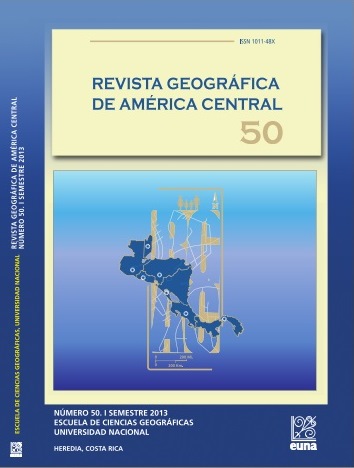UN ENFOQUE HACIA LA SOSTENIBILIDAD EN REGIONES TRANSFRONTERIZAS
Palabras clave:
Región transfronteriza, desarrollo territorial, desarrollo sustentable, evaluación de sustentabilidadResumen
Dadas las condiciones periféricas de la mayoría de regiones transfronterizas (RTF) en el mundo, uno de sus desafíos constantes ha sido la gestión y protección de los recursos naturales así como el mejoramiento de las condiciones socioeconómicas. El objetivo de este artículo es identificar los elementos más importantes a considerar en la senda para promover el desarrollo sostenible en las RTF. Comienza con un repaso de las experiencias de desarrollo en estos tipos de regiones en Europa, Norte América y Asia. Continúa haciendo la distinción entre desarrollo regional convencional y el enfoque de RTF con el fin de establecer los aspectos clave en la aplicación de sostenibilidad en estos espacios. El artículo concluye planteando un método de evaluación que facilita la planificación de sostenibilidad en RTF contribuir al desarrollo del tema.
Referencias
Avendaño, D. (2008). Sustainable spatial planning applied to decision
making in cross border regions; Case study: Las Tablillas (Costa Rica - Nicaragua border). [Unpublished master’s thesis, Saxion University of Applied Sciences (Deventer, Netherlands) and University of Greenwich (London, United Kingdom].
Blatter, J. (2000). Emerging cross border regions as a step towards sustainable development? Experiences and considerations from examples in Europe and North America. International Journal of Economic Development, 2(3), 402-439.
Blatter, J. (2001). Cross border regions: A step towards sustainable development? Experiences and considerations from examples in Europe and North America. In P. Ganster (Ed.), Cooperation, Environment, and Sustainability in Border Regions, p.33. San Diego: San Diego State University Press.
Blatter, J. (2004a). Beyond hierarchies and networks: institutional logics and change in transboundary spaces. International Journal of Policy, Administration, and Institutions, 16(4), 503-526.
Blatter, J. (2004b). From “spaces of place” to “spaces of flows”? Territorial and functional governance in cross border regions in Europe
and North America.” International Journal of Urban and Regional Research, 28 (3), 530-548
Brenner, N. (2004). New state spaces: Urban governance and the rescaling of statehood. Oxford: Oxford University Press.
Castells, M. (1996). The rise of the network society. Oxford: Blackwell
.
Castells, M. (1999). Grassrooting the space of flows. Urban Geography, 20(4), 294-302.
Clement, N. (2001). International transboundary collaboration: A policy oriented conceptual framework. In P. Ganster (Ed.), Cooperation, Environment, and Sustainability in Border Regions (p.432). San Diego: San Diego State University Press.
Clement, N., Ganster, P. & Sweedler, A. (2005). Environment, development, and security in border regions: perspectives from Europe and North America. In P. Ganster & D. Lorey (Eds.), Borders and Border Politics in a Globalizing World (p. 376). Oxford: Rowman & Littlefield Publishers.
Evans, G., Kuah, K. & von Palgrave, C. (2000). Where China meets Southeast Asia: Social and cultural change in the border region. New
York: Institute of Southeast Asian Studies.
Ganster, P. (2001). Cooperation, environment, and sustainability in border regions. (p. 432). San Diego: San Diego State University Press.
Ganster, P. & Lorey, D. (2005). Borders and border politics in a globalizing world. Oxford: Rowman & Littlefield Publishers.
Girot, P. (1997). Border regions and transborder conservation in Central America. In P. Ganster & D. Lorey (Eds.), Borders and BorderPolitics in a Globalizing World (p. 376). Oxford: Rowman & Littlefield Publishers.
Guo, R. & Lee, C. (2000). Sustainable development of cross-border regions: A methodological study. Chinese Geographical Science,
(4), 343-347
Hall, P. (2008). Opportunities for democracy in cross-border regions? Lessons from the Øresund region. Regional Studies, 42 (3), 423-435.
Harvey, D. (2006). Spaces of global capitalism; towards a theory of uneven geographical development. London: Verso.
Jacobs, A. (2004). Seeing change. In S. Wheeler & T. Beatly (Eds.), The Sustainable Urban Development Reader. New York: Routledge
Perkmann.
Kiy, R. & Worth, J. (1998). Environmental management on North America’s borders. Texas: TAMU Press.
Mamadouh, V., Kramsch, O. & Van der Velde, M. (2004). Articulating
local and global scales. Tijdscheift voor Economische en Sociale Geografie, 95(3), 455-466.
Masuda, J. & Crooks, V. (2007). Introduction: (re)thinking the scales of lived experience. Area, 39(3), 257-258.
Perkmann, M. (2003). Cross border regions in Europe: Significance and drivers of regional cross-border cooperation. European Urban and
Regional Studies, 10(2), 153-171.
Perkmann, M. (2007). Construction of new territorial scales: A framework and case study of the Euregio cross-border region. Regional Studies, 41(2), 253-266.
Perkmann, M. & Sum, L. (2002). Globalization, regionalization and
cross-border regions. New York: Palgrave Macmillan.
Roberts, P. (2003). Sustainable development and social justice: Spatial priorities and mechanisms for delivery. Social Inquiry, 73(2), 228-244.
Scott, J. (1999). European and North American contexts for cross-border regionalism. Regional Studies, 33(7), 605-617.
Sum, N. (2002). Globalization, regionalization and cross border modes of growth in East Asia: the (re)constitution of time-space governance.
In M. Perkmann & N. Sum (Eds.), Globalization, Regionalization
and Cross-Border Regions (p. 288). New York: Palgrave Macmillan.
Thierstein, A. & Walser, M. (1999, August). Sustainable regional development: interplay of top-down and bottom-up approaches. ERSA conference papers: European Regional Science Association. Retrieved
from: http://www-sre.wu-wien.ac.at/ersa/ersaconfs/ersa99/Papers/
a139.pdf
Whitehead, M. (2007). Spaces of sustainability: Geographical perspectives on the sustainable society. New York: Routledge.
Wu, C. (1998). Cross-border development in Europe and Asia. GeoJournal, 44(3), 189-201.
Wu, C. (2001). Cross border development in a changing world: Redefining regional development policies. In D. Edgington, A. Fernandez & C. Hoshino (Eds.), New Regional Development Paradigms: New regions, concepts, issues and practices (pp. 21-38). Westport, Connecticut: Greenwood Press.
Wu, C. (1998). Cross-border development in Europe and Asia. GeoJournal, 44(3), 189-201.
Descargas
Cómo citar
Número
Sección
Licencia
Política propuesta para Revistas que ofrecen Acceso Abierto
Los autores que publican en esta revista están de acuerdo con los siguientes términos:
a. Los autores conservan los derechos de autor y garantizan a la revista el derecho de ser la primera publicación del trabajo, bajo la Licencia https://creativecommons.org/licenses/by-nc-sa/4.0/deed.es, que permite a otros compartir con un reconocimiento de la autoría del trabajo y la publicación inicial en esta revista.
b. Los autores pueden establecer por separado acuerdos adicionales para la distribución no exclusiva de la versión de la obra publicada en la revista (por ejemplo, situarlo en un repositorio institucional o publicarlo en un libro), con un reconocimiento de su publicación inicial en esta revista. Esos acuerdos adicionales deben respetar los términos de la licencia: es decir: no involucrar fines de lucro y compartir con la misma licencia.
c. Se anima a los autores a archivar el post-print o versión de editor/PDF en repositorios de acceso abierto.







 REVGEO se encuentra bajo la licencia https://creativecommons.org/licenses/by-nc-sa/4.0/deed.es
REVGEO se encuentra bajo la licencia https://creativecommons.org/licenses/by-nc-sa/4.0/deed.es
.svg_4.png)

_(1).png)
_(1)_(1)_(1)_1.png)
(2)(1)(1)(1).png)
